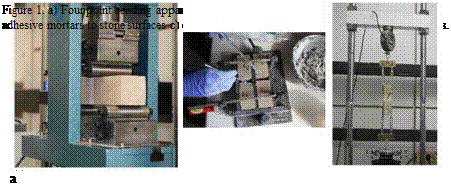 |
The Aktites and Mounichea stone samples were cut and shaped into specimens with dimensions of: (a) 4^4×4 cm and were used to measure the compressive strength of the stone and (b) 4x4x8 cm that were used to test bonding with the designed mortars. Before applying the adhesive mortars, the stone faces were first incised using special mechanical tools to provide a rough surface and were then wetted. Afterwards, the mortar was partially applied to the stone surface and then the stone specimens were “filled” with mortar by placing them levelly with the aid of special joint clamps (Figure 1b). The joint was kept moist with damp cotton gauze and a polyethylene sheet. The specimens were then placed in a storage chamber for 28 days, according to the conditions described in EN 1015-11:1999. Home designed equipment for both four point flexural (Ff-4pb) (Figure 1a) and direct tensile (Ft) (Figure 1c) strength tests, were used for measuring the adhesive performance of the bonded stone-mortar specimens (4x4x17 cm) (Whittaker 1992).
The evolution of hydration and carbonation of powder samples was assessed by XRD, mercury intrusion porosimetry (MIP), FTIR, DTA/TG, EDXRF and SEM. By identifying calcium silicate hydrates (CSH) and calcium aluminate hydrates (CAH) at different ages, not only qualitatively, but also semi-quantitatively, the hydration and carbonation processes could be monitored. The mineralogical analysis was investigated by XRD with a Siemens D-500 diffractometer (40 kV/35 mA); the spectra were collected
between 50 and 60o on the 20 scale, with a step of 0.03o/5s. SEM analysis was carried out in fractured surfaces, using a FEI Quanta Inspect scanning electron microscope. DTA/TG was operated with a Setaram thermal analyser in static air atmosphere up to 1000 oC at a rate of 10 oC/min. The FTIR analysis of KBr pellets was carried out using a Perkin-Elmer spectrophotometer in the spectral range of 400-4000 cm-1. MIP measurements were recorded using a Quantachrome Autoscan 60 porosimeter, in the range of 2-4000 nm. The physical properties of the stone and mortars were further studied by water absorption at atmospheric pressure, according to EN 13755:2002, as well as by capillary water absorption measurements according to EN 1015-18:1995 (for mortars) and EN 1925:1999 (for stones).
 19 ноября, 2015
19 ноября, 2015  Pokraskin
Pokraskin  Опубликовано в рубрике
Опубликовано в рубрике 